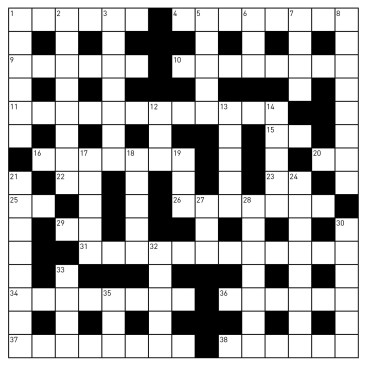Print the PDF from the link above (when signed in) to write-in the answers.

ACROSS
1. The capacity to do work; often expressed in Btu or joules
4. Common term for water vapor
9. Describes efforts to stop water leaks through siding with caulk or stop air leaks with fiberglass insulation
10. Design load accounting for the weight of the materials in a building
11. Forms on surfaces that drop below dew point temperature
15. 1/36 of a yard (abbrev.)
16. Things learned by observing buildings in service; often modified by “hard” when they result in a callback, loss of profit, or litigation
20. The ratio of the circumference of a circle to its diameter
22. Abbreviation for 10 Across
23. A ________ ; describes a moment of sudden realization, like when a client realizes that new windows won’t save as much energy as your recommendation to insulate the attic
25. Initial response to a client asking you to fix the leaks causing water droplets on the inside of window panes; sometimes better not to say this out loud before explaining the real cause of those droplets
26. A general type of material used for insulation that excites great controversy for some around its health and environmental impacts
29. Approx. 0.4 inch (abbrev.)
31. The field of engineering concerned with the properties of moist air
34. What is required in front of the reflective surface of a radiant barrier
36. Emit vapors from certain compounds with high vapor pressure and low water solubility
37. A building professional who focuses on performance; those in the forensic branch of the profession are often tasked with explaining why a building has failed and coming up with a solution for fixing it
DOWN
1. Frequently modified by “stack” (when referring to the air movement caused by warm air rising and cold air falling) or “throttling” (when referring to the inward drive of water vapor)
2. Describes periods of time, such as service life and warranty duration
3. Small “pinning stones” (made of sandstone, flint, or oyster shells) pushed into the mortar of some stone and brick buildings during the 17th and 18th centuries; the technique using these is purported to shield the mortar from weather
5. Apparent, not hidden or subtle; Armin Rudd used this to describe the type of objections that occupants may have to low-quality indoor air
6. How many of us feel because we missed the last two years of Building Science Summer Camp
7. Preposition commonly used with “completion” in construction contracts to define when a buyer may take possession of a property and when to release final payment to the contractor
8. The exposed pores on a cut piece of wood, which are more prone to capillary suction than other parts of the board
12. Moisture that has soaked into masonry or stucco cladding may be driven through the wall as a vapor when this comes out
13. Prefix applied to a color at the end of the light spectrum with longer wave lengths; radiation emitted from this part of the spectrum can be used to detect differences in the temperatures of materials in building assemblies
14. Period of time when earth temperatures are coolest in any given climate zone (when 12 Down is not visible)
17. A measure of the consistency of fresh concrete before it sets; used as a test of the workability of a concrete mix
18. A branch of knowledge; has yet to be applied to building knowledge
19. The upward flow of this liquid in trees is often cited as evidence that capillary action can lift water hundreds of feet
21. Action taken to limit conductive heat losses
24. Preferable state for an energy-efficient house, provided there are sealed-combustion or power-vented appliances (or no combustion appliances) and the home has effective controlled ventilation
27. Lumber (abbrev.)
28. After great debate on the value of inset stapling vs. face stapling when installing paper-faced fiberglass batts, it turns out inset stapling has _____________ after all—namely, when installing drywall with adhesive (two words)
30. A soft mineral that forms within layers of sedimentary rock; the U.S.—the largest consumer of it worldwide—uses it mostly for drywall, about 30 billion square feet worth
32. A recurring loop; often applied to “freeze-thaw” and “wetting-drying”
33. Math for finding sun angles, analyzing electrical circuits, and developing hip-valley rafter ratios (shortened form)
35. Critical beneath window sills and door thresholds for managing water
Answers can be found here.
